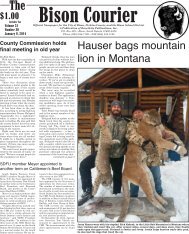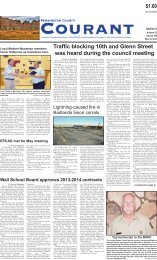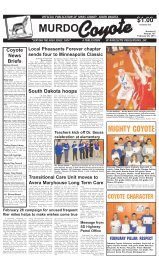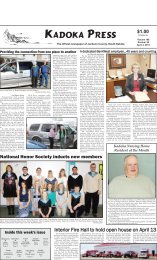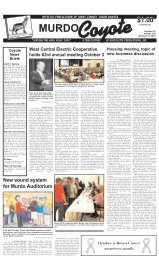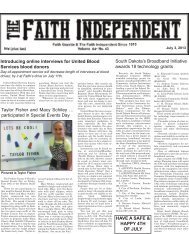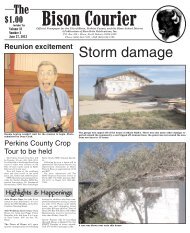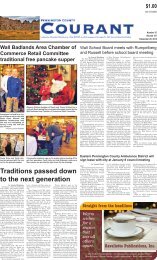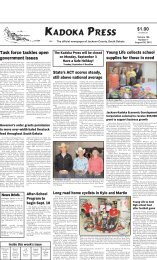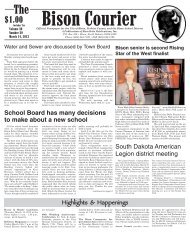Faith Independent - Pioneer Review
Faith Independent - Pioneer Review
Faith Independent - Pioneer Review
You also want an ePaper? Increase the reach of your titles
YUMPU automatically turns print PDFs into web optimized ePapers that Google loves.
April 10, 2013 • The <strong>Faith</strong> <strong>Independent</strong> • Page 9<br />
Grants to help farms & ranches<br />
build resilience to drought<br />
WASHINGTON, April 4, 2013<br />
- Today, Agriculture Secretary<br />
Tom Vilsack announced the<br />
award of $5.3 million in Conservation<br />
Innovation Grants to develop<br />
approaches and technology<br />
that will help producers adapt to<br />
extreme climate changes that<br />
cause drought. These grants will<br />
fund projects benefiting several<br />
states that were significantly impacted<br />
by last year's drought. The<br />
United States Department of<br />
Agriculture (USDA) remains focused<br />
on carrying out its mission,<br />
despite a time of significant<br />
budget uncertainty. Today's announcement<br />
is one part of the department's<br />
efforts to strengthen<br />
the rural economy.<br />
"USDA is working diligently to<br />
help American farmers and<br />
ranchers rebound from last year's<br />
drought and prepare for future<br />
times of climatic extremes," Vilsack<br />
said. "Conservation Innovation<br />
Grants are an excellent way<br />
to invest in new technology and<br />
approaches that will help our<br />
farmers, ranchers and rural communities<br />
be more resilient in the<br />
future."<br />
The grants will address<br />
drought-related issues, such as<br />
grazing management, warm season<br />
forage systems, irrigation<br />
strategies and innovative cropping<br />
systems.<br />
Recipients plan to evaluate innovative,<br />
field-based conservation<br />
technologies and approaches,<br />
leading to improvements like enhancing<br />
soil's ability to hold<br />
water, evaluating irrigation<br />
water use and installing grazing<br />
systems that are more tolerant to<br />
drought.<br />
Examples of projects include:<br />
South Dakota State University:<br />
Received $713,000 to establish<br />
four grazing management<br />
demonstrations on South Dakota<br />
and Nebraska ranches. Producers<br />
can observe and demonstrate the<br />
impacts of innovative grazing<br />
management practices on their<br />
land's ability to recover from the<br />
2012 and future droughts<br />
through the use of rainout shelters.<br />
Intertribal Buffalo Council:<br />
Received $640,000 to evaluate<br />
how traditional/historical practices<br />
aided tribes in dealing with<br />
drought, developing a best practices<br />
database, and using that information<br />
for training and<br />
demonstration projects. This<br />
grant will support 57 tribes in 19<br />
states (Alaska, Arizona, California,<br />
Colorado, Idaho, Iowa,<br />
Kansas, Minnesota, Montana,<br />
Nebraska, New Mexico, North<br />
Dakota, Oklahoma, Oregon,<br />
South Dakota, Utah, Washington,<br />
Wisconsin and Wyoming.)<br />
Summaries of all projects selected<br />
for 2013 Conservation Innovation<br />
Grants are available at<br />
http://www.nrcs.usda.gov/technical/cig/index.html<br />
NRCS has offered this grant<br />
program since 2004, investing in<br />
ways to demonstrate and transfer<br />
efficient and environmentally<br />
friendly farming and ranching<br />
practices. This specific announcement<br />
of program funding was in<br />
response to last year's historic<br />
drought.<br />
Conservation Innovation<br />
Grants projects are funded by the<br />
Environmental Quality Incentives<br />
Program and awarded<br />
through a competitive grants<br />
process. At least 50 percent of the<br />
total cost of projects must come<br />
from non-federal matching funds,<br />
including cash and in-kind contributions<br />
provided by the grant recipient.<br />
For more on grant recipients or<br />
Conservation Innovation Grants,<br />
visit www.nrcs.usda.gov/technical/cig/index.html.<br />
USDA has made a concerted<br />
effort to deliver results for the<br />
American people, even as USDA<br />
implements sequestration - the<br />
across-the-board budget reductions<br />
mandated under terms of<br />
the Budget Control Act. USDA<br />
has already undertaken historic<br />
efforts since 2009 to save more<br />
than $700 million in taxpayer<br />
funds through targeted, commonsense<br />
budget reductions. These<br />
reductions have put USDA in a<br />
better position to carry out its<br />
mission, while implementing sequester<br />
budget reductions in a<br />
fair manner that causes as little<br />
disruption as possible.<br />
Safe Digging Month kicks off<br />
spring construction season<br />
As South Dakotans prepare for<br />
spring construction and planting<br />
projects, the South Dakota Public<br />
Utilities Commission and the<br />
South Dakota One Call Board remind<br />
residents to always call 811<br />
a few days before any digging<br />
project to request that underground<br />
utilities be marked.<br />
When calling 811, homeowners<br />
and contractors are connected to<br />
the South Dakota One Call center<br />
which notifies the appropriate<br />
utility companies of their intent<br />
to dig. Professional locators are<br />
then dispatched to the digging<br />
site to mark the approximate locations<br />
of underground lines with<br />
flags, paint or both. The 811 call<br />
and the subsequent marking of<br />
utilities are free to the homeowner<br />
or contractor.<br />
"Calling 811 is a crucial step in<br />
any excavation project," said PUC<br />
Chairman Gary Hanson. "The<br />
time investment to dial the threedigit<br />
number is minimal, but the<br />
potential savings, in terms of personal<br />
safety and infrastructure<br />
preservation, is priceless."<br />
Striking a single line can cause<br />
injury, repair costs, fines and inconvenient<br />
outages. Every digging<br />
project, no matter how large<br />
or small, warrants a call to 811.<br />
Installing a mailbox, building a<br />
deck and planting a tree are all<br />
examples of digging projects that<br />
should only begin a few days after<br />
a call to 811.<br />
State law requires notification<br />
to the One Call center at least 48<br />
hours before digging. Weekend<br />
projects should be called in to 811<br />
the Monday or Tuesday before.<br />
"Callers to 811 should be prepared<br />
to give the location of their<br />
dig site as well as the start time<br />
and duration of the dig activity,"<br />
said South Dakota One Call<br />
Board President Kurt Pfeifle of<br />
Mid-Dakota Rural Water System.<br />
"The locating process is a wellhoned<br />
procedure that works well<br />
and truly saves lives and facilities."<br />
In 2012, the South Dakota One<br />
Call center received more than<br />
133,000 locate requests. As a result<br />
787,600 locate tickets were<br />
issued to utilities to mark underground<br />
facilities.<br />
The depth of utility lines can<br />
vary for a number of reasons,<br />
such as erosion, previous digging<br />
projects and uneven surfaces.<br />
Utility lines need to be properly<br />
marked because even when digging<br />
only a few inches, the risk of<br />
striking an underground utility<br />
line still exists.<br />
Read more about digging<br />
safely, including a proclamation<br />
by Gov. Dennis Daugaard naming<br />
April as Safe Digging Month, at<br />
www.puc.sd.gov/safedigging.<br />
Learn about the South Dakota<br />
One Call program, laws and color<br />
codes for marking lines at<br />
www.SDOneCall.com.<br />
Place a Classified Ad...<br />
in The<br />
<strong>Faith</strong> <strong>Independent</strong><br />
967-2160/FAX 967-2160<br />
Students get chance<br />
to send art to Washington<br />
PIERRE, S.D. – The competition<br />
that puts the artwork of<br />
South Dakota students in the nation’s<br />
Capitol is coming up, and<br />
the South Dakota Arts Council, in<br />
cooperation with U.S. Rep. Kristi<br />
Noem, is now accepting entries.<br />
Each spring, a nationwide high<br />
school arts competition is sponsored<br />
by the members of the U.S.<br />
House of Representatives. The<br />
Congressional Art Competition is<br />
an opportunity to recognize and<br />
encourage the artistic talent in<br />
the nation, as well as in each congressional<br />
district.<br />
The contest is open to all South<br />
Dakota high school students. The<br />
first-place winning entry will be<br />
displayed in the Cannon Tunnel<br />
of the United States Capitol for<br />
one year. The winning artist will<br />
be invited to a reception highlighting<br />
their artwork in conjunction<br />
with the exhibit<br />
ribbon-cutting ceremony. The second-place<br />
winning entry will be<br />
displayed in Rep. Noem’s Washington,<br />
D.C., office. Cash awards<br />
are also given to the first- and<br />
second-place winners by South<br />
Dakotans for the Arts, a nonprofit,<br />
non-partisan agency whose<br />
primary purpose is to advance the<br />
arts in South Dakota.<br />
The Arts Council will only accept<br />
digital submissions on behalf<br />
of Rep. Noem. Students should<br />
send high-resolution JPEG images<br />
along with PDFs of the student<br />
application forms to<br />
rebecca.cruse@state.sd.us. Submissions<br />
must be received by<br />
11:59 p.m., Wednesday, May 1.<br />
Winners will be notified May 3<br />
and will be responsible for shipping<br />
their artwork and application<br />
forms to the SDAC office. The<br />
South Dakota Arts Council will<br />
have the artwork framed and will<br />
ship it to Washington, D.C. for<br />
the student.<br />
If you have further questions,<br />
please contact Rebecca Cruse at<br />
1-800-952-3625 or via e-mail at<br />
rebecca.cruse@state.sd.us.<br />
The South Dakota Arts Council,<br />
an office of the South Dakota<br />
Department of Tourism, is a state<br />
agency serving South Dakotans<br />
and their communities through<br />
the arts with funding from the<br />
National Endowment for the Arts<br />
and the State of South Dakota.<br />
The South Dakota Department<br />
of Tourism is comprised of the Office<br />
of Tourism, the South Dakota<br />
Arts Council, and the South<br />
Dakota State Historical Society.<br />
The Department is led by Secretary<br />
James D. Hagen.<br />
Artwork Specifications:<br />
Each piece of art can be no<br />
larger than 28” x 28” x 4,” including<br />
the frame (unframed pieces<br />
are preferred, and the SDAC will<br />
have the work framed before<br />
sending to Washington, D.C.).<br />
Artwork cannot weigh more than<br />
15 lbs. Accepted media for artwork<br />
are as follows:<br />
•Paintings: oil, acrylics, watercolor,<br />
etc.<br />
•Drawings: pastels, colored<br />
pencil, pencil, charcoal, ink,<br />
marker<br />
•Collage: Must be two dimensional<br />
•Prints: lithographs, silkscreen,<br />
block prints<br />
•Mixed Media<br />
•Computer-Generated Art<br />
•Photography<br />
Each entry must be original in<br />
concept, design, and execution<br />
and may not violate any U.S.<br />
copyright laws. Work entered<br />
must be in the original medium.<br />
No scanned reproductions of<br />
paintings or drawings will be allowed.



